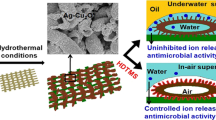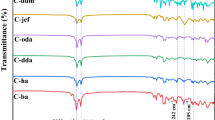Abstract
Oil spillage from petroleum industry and also the mixing of industrial wastewater into water bodies are some of the major ways of water pollution. Low cost, biodegradable and biocompatible materials are highly required for tackling the pollution problem without causing further indirect pollution. In this work, a superamphiphilic nanomarigold-like β-Ni(OH)2 based coating on commercial cotton fabric (bNH-CF) has been fabricated by a simple one pot hydrothermal process. The fabric is able to simultaneously separate oil and water from oil–water mixtures where the sample is pre-wetted by either oil or water. The coated fabric shows under-oil superhydrophobicity and underwater superoleophobicity. The sample is able to separate both light and heavy oils from oil–water mixtures, oil-alkaline/acidic/salt/hot water mixtures with ~ 99% separation efficiency. In addition, it shows an excellent reusability (up to 50 cycles) with superior mechanical and chemical durability under harsh conditions without affecting the nanomarigold-like structure of β-Ni(OH)2 that developed upon the cotton fabric. The presence of β-Ni(OH)2 coated fabric shows significant bacterial (E. coli and S. aureus) and fungal (C. albicans) reduction in contaminated water. Hence, the coated cotton fabric fabricated by cost effective process can be useful for hassle-free simultaneous separation of oil–water mixtures as well as removal/growth inhibition of microbes from wastewater. The coated fabric also shows significant electrical conductivity. On the other hand, hexadecyltrimethoxysilane modified β-Ni(OH)2 coated fabric (bNHS-CF) shows excellent in-air superhydrophobicity, self-cleaning and anti-staining properties.Thus, the versatility of coated fabric can broaden the domain of practical applications as antimicrobial and superwetting multifunctional textiles.
Graphic abstract














Similar content being viewed by others
References
Agarwal S, Nekouei F, Kargarzadeh H, Nekouei S, Tyagi I, Gupta VK (2016) Preparation of nickel hydroxide nanoplates modified activated carbon for malachite green removal from solutions: kinetic, thermodynamic, isotherm and antibacterial studies. Process Saf Environ 102:85–97. https://doi.org/10.1016/j.psep.2016.02.011
Babič MN, Gunde-Cimerman N, Vargha M (2017) Fungal contaminants in drinking water regulation? a tale of ecology, exposure, purification and clinical relevance. Int J Environ Res Public Health 14:636. https://doi.org/10.3390/ijerph14060636
Cabral JPS (2010) Water microbiology. bacterial pathogens and water. Int J Environ Res Public Health 7:3657–3703. https://doi.org/10.3390/ijerph7103657
Cao G, Zhang W, Jia Z et al (2017) Dually prewetted underwater superoleophobic and under oil superhydrophobic fabric for successive separation of light oil/ water/heavy oil three-phase mixtures. ACS Appl Mater Interfaces 9:36368–36376. https://doi.org/10.1021/acsami.7b08997
Cao H, Zheng H, Liu K, Warner JH (2010) Bioinspired peony-like β-Ni(OH)2 nanostructures with enhanced electrochemical activity and superhydrophobicity. Chem Phys Chem 11:489–494. https://doi.org/10.1002/cphc.200900665
Chang Y-H, Huang Y-T, Lo MK, Lin C-F, Chen C-M, Feng SP (2014) Electrochemical fabrication of transparent nickel hydroxide nanostructures with tunable superhydrophobicity/superhydrophilicity for 2D microchannels application. J Mater Chem A 2:1985–1990. https://doi.org/10.1039/C3TA13882H
Chen J, Zhou Y, Zhou C, Wen X, Xu S, Cheng J, Pi P (2019) A durable underwater superoleophobic and underoil superhydrophobic fabric for versatile oil/water separation. Chem Eng J 370:1218–1227. https://doi.org/10.1016/j.cej.2019.03.220
Cheng Z, Wang J, Lai H et al (2015) pH-controllable on-demand oil/water separation on the switchable superhydrophobic/superhydrophilic and underwater low-adhesive superoleophobic copper mesh film. Langmuir 31:1393–1399. https://doi.org/10.1021/la503676a
Coenen K, Gallucci F, Mezari B, Hensen E, Annaland MvS (2018) An in-situ IR study on the adsorption of CO2 and H2O on hydrotalcites. J CO2 Util 24:228–239. https://doi.org/10.1016/j.jcou.2018.01.008
Dogra V, Kaur G, Kaur A, Kumar R, Kumar S (2018) In vitro assessment of antimicrobial and genotoxic effect of metallosurfactant based nickel hydroxide nanoparticles against Escherichia coli and its genomic DNA. Colloids Surf B 170:99–108. https://doi.org/10.1016/j.colsurfb.2018.05.069
Du X, You S, Wang X, Wang Q, Lu J (2017) Switchable and simultaneous oil/water separation induced by prewetting with a superamphiphilic self-cleaning mesh. Chem Eng J 313:398–403. https://doi.org/10.1016/j.cej.2016.12.092
El-Shishtawy RM, Asiri AM, Abdelwahed NAM, Al-Otaibi MM (2011) In situ production of silver nanoparticle on cotton fabric and its antimicrobial evaluation. Cellulose 18:75–82. https://doi.org/10.1007/s10570-010-9455-1
Emam HE, Ahmed HB, Bechtold T (2017) In-situ deposition of Cu2O micro-needles for biologically active textiles and their release properties. Carbohydr Polym 165:255–265. https://doi.org/10.1016/j.carbpol.2017.02.044
Emam HE, Manian AP, Široká, et al (2014) Copper (I) oxide surface modified cellulose fibers–synthesis, characterization and antimicrobial properties. Surf Coat Tech 254:344–351. https://doi.org/10.1016/j.surfcoat.2014.06.036
Gao X, Wen G, Guo Z (2018) Durable superhydrophobic and underwater superoleophobic cotton fabrics growing zinc oxide nanoarrays for application in separation of heavy/light oil and water mixtures as need. Coll Surf A Physicochem Eng Asp 559:115–126. https://doi.org/10.1016/j.colsurfa.2018.09.041
Ge D, Yang L, Wang C, Lee E, Zhang Y, Yang S (2015) A multi-functional oil–water separator from a selectively pre-wetted superamphiphobic paper. Chem Commun 51:6149–6152. https://doi.org/10.1039/C4CC09813G
Hong HR, Kim J, Park CH (2018) Facile fabrication of multifunctional fabrics: use of copper and silver nanoparticles for antibacterial, superhydrophobic, conductive fabrics. RSC Adv 8:41782–41794. https://doi.org/10.1039/C8RA08310J
Hou Y, Wang B, Zhang T, Pei J, Li Q, Zhang T (2020) A mechanically robust copper mesh with switchable wettability and antibacterial activity for selective oil–water separation. Appl Organomet Chem. https://doi.org/10.1002/aoc.5713
Hu R, Yang J, Yang P, Wu Z, Xiao H, Liu Y, Lu M (2020) Fabrication of ZnO@Cotton fabric with anti-bacterial and radiation barrier properties using an economical and environmentally friendly method. Cellulose 27:2901–2911. https://doi.org/10.1007/s10570-019-02965-1
Irwin RJ (ed) (1997) Environmental contaminants encyclopedia: benzene entry. National Park Service Water Resources Divisions, Water Operations Branch, Fort Collins Colorado
Ji W, Wang H, Yao Y, Wang R (2019) Mg(OH)2 and PDMS-coated cotton fabrics for excellent oil/ water separation and flame retardancy. Cellulose 26:6879–6890. https://doi.org/10.1007/s10570-019-02576-w
Karimi L, Yazdanshenas ME, Khajavi R, RashidiA MM (2014) Using graphene/TiO2 nanocomposite as a new route for preparation of electroconductive, self-cleaning, antibacterial and antifungal cotton fabric without toxicity. Cellulose 21:3813–3827. https://doi.org/10.1007/s10570-014-0385-1
Kokot S, Czarnik-Matusewicz B, Ozaki Y (2002) Two dimensional correlation spectroscopy and principal component analysis studies of temperature-dependent IR spectra of cotton–cellulose. Biopolymers 67:456–469. https://doi.org/10.1002/bip.10163
Lee YS, Kaang BK, Han N, Lee H-J, Choi WS (2018) An anti-overturn Janus sponge with excellent floating stability for simultaneous pollutant remediation and oil/water separation. J Mater Chem A 6:16371–16381. https://doi.org/10.1039/C8TA04462G
Li HB, Yu MH, Wang FX, Liu P, Liang Y, Xiao J, Wang CX, Tong YX, Yang FW (2012) Amorphous nickel hydroxide nanospheres with ultrahigh capacitance and energy density as electrochemical pseudocapacitor materials. Nat Commun 4:1894. https://doi.org/10.1038/ncomms2932
Li L, Xu J, Lei J et al (2015) A one-step, cost-effective green method to in situ fabricate Ni(OH)2 hexagonal platelets on Ni foam as binder-free supercapacitor electrode materials. J Mater Chem A 3:1953. https://doi.org/10.1039/C4TA05156D
Lin L, Zhang X, He N, Liu J, XinQ GH (2019) Operando dual beam FTIR study of hydroxyl groups and Zn species over defective HZSM-5Zeolite supported zinc catalysts. Catalysis 9:100. https://doi.org/10.3390/catal9010100
Nguyen DD, Tai N-H, Lee S-B, Kuo W-S (2012) Superhydrophobic and superoleophilic properties of graphene-based sponges fabricated using a facile dip coating method. Energy Environ Sci 5:7908–7912. https://doi.org/10.1039/C2EE21848H
Perelshtein I, Applerot G, Perkas N, Grinblat J, Gedanken A (2012) A one-step process for the antimicrobial finishing of textiles with crystalline TiO2 nanoparticles. Chem Eur J 18:4575–4582. https://doi.org/10.1002/chem.201101683
Radetić M, Marković D (2019) Nano-finishing of cellulose textile materials with copper and copper oxide nanoparticles. Cellulose 26:8971–8991. https://doi.org/10.1007/s10570-019-02714-4
Ruan C, Ai K, Li X, Lu L (2014) A superhydrophobic sponge with excellent absorbency and flame retardancy. Angew Chem Int Ed 53:5556–5560. https://doi.org/10.1002/anie.201400775
Seth M, Khan H, Jana S (2020) Hierarchically structured alpha-nickel hydroxide based superhydrophobic and antibacterial coating on cellulosic materials for oil-water separation. Mater Chem Phys 249:123030. https://doi.org/10.1016/j.matchemphys.2020.123030
Seth M, Khan H, Bhowmik R, Karmakar S, Jana S (2020) Facile fabrication of fluorine free zirconium zinc stearate based superhydrophobic and superoleophilic coating on cotton fabric with superior antibacterial property. J Sol-Gel Sci Technol 94:127–140. https://doi.org/10.1007/s10971-019-05079-z
Singh AK, Mishra S, Singh JK (2019) Underwater superoleophobic biomaterial based on waste potato peels for simultaneous separation of oil/water mixtures and dye adsorption. Cellulose 26:5497–5511. https://doi.org/10.1007/s10570-019-02458-1
Suresh S, Karthikeyan S, Saravanan P, Jayamoorthy K (2016) Comparison of antibacterial and antifungal activities of 5-amino-2-mercaptobenzimidazole and functionalized NiO nanoparticles. Karbala Int J Mod Sci 2:188–195. https://doi.org/10.1016/j.kijoms.2016.05.001
Tian D, Zhang X, Tian Y, Wu Y, Wang X, Zhai J, Jiang L (2012) Photo-induced water–oil separation based on switchable superhydrophobicity–superhydrophilicity and underwater superoleophobicity of the aligned ZnO nanorod array-coated mesh films. J Mater Chem 22:19652. https://doi.org/10.1039/C2JM34056A
Tie L, Li J, Liu M, Guo Z, Liang Y, Liu W (2018a) Dual superlyophobic surfaces with superhydrophobicity and underwater superoleophobicity. J Mater Chem A 6:11682. https://doi.org/10.1039/C8TA02933D
Tie L, Li J, Liu M, Guo Z, Liang Y, Liu W (2018b) Facile fabrication of superhydrophobic and underwater superoleophobic coatings. ACS Appl Nano Mater 1:4894–4899. https://doi.org/10.1021/acsanm.8b01074
Wang J, Wang H (2019) Integrated device based on cauliflower-like nickel hydroxide particles–coated fabrics with inverse wettability for highly efficient oil/hot alkaline water separation. J Colloid Interface Sci 534:228–238. https://doi.org/10.1016/j.jcis.2018.09.028
Wang M, Zhang Z, Wang Y, Zhao X, Yang M, Men X (2020) Superwetting fabrics towards multifunctional applications: oil/water separation, anti-fouling and flame-retardance. Appl Surf Sci 508:145265. https://doi.org/10.1016/j.apsusc.2020.145265
Yuan C, Hou L, Li D, Shen L, Zhang F, Zhang X (2011) Synthesis of flexible and porous cobalt hydroxide/conductive cotton textile sheet and its application in electrochemical capacitors. Electrochim Acta 56:6683–6687. https://doi.org/10.1016/j.electacta.2011.05.050
Zhang F, Zhang WB, Shi Z, Wang D, Jin J, Jiang L (2013) Nanowire-haired inorganic membranes with superhydrophilicity and underwater ultralow adhesive superoleophobicity for high-efficiency oil/water separation. Adv Mater 25:4192–4198. https://doi.org/10.1002/adma.201301480
Zhang X, Li Z, Liu K, Jiang L (2013) Bioinspired multifunctional foam with self-cleaning and oil/water separation. Adv Funct Mater 23:2881–2886. https://doi.org/10.1002/adfm.201202662
Zhang YY, Xu Q, Fu F, Liu X (2016) Durable antimicrobial cotton textiles modified with inorganic nanoparticles. Cellulose 23:2791–2808. https://doi.org/10.1007/s10570-016-1012-0
Zhou Y-N, Li J-J, Luo Z-H (2015) PhotoATRP-based fluorinated thermosensitive block copolymer for controllable water/oil separation. Ind Eng Chem Res 54:10714–10722. https://doi.org/10.1021/acs.iecr.5b02394
Zimmermann J, Reifler FA, Fortunato G, Gerhardt LC, Seeger S (2008) A simple, one step approach to durable and robust superhydrophobic textiles. Adv Funct Mater 18:3662–3669. https://doi.org/10.1002/adfm.200800755
Acknowledgment
Malobi Seth thankfully acknowledges Department of Science and Technology (DST), Government of India for providing her Ph.D. Research Fellowship under DST-Inspire Fellowship Scheme. All the authors acknowledge the tremendous help rendered by Electron Microscopy Section for some characterizations of materials.
Author information
Authors and Affiliations
Corresponding author
Ethics declarations
Conflict of interest
The authors declare that they have no conflict of interest.
Additional information
Publisher's Note
Springer Nature remains neutral with regard to jurisdictional claims in published maps and institutional affiliations.
Electronic supplementary material
Below is the link to the electronic supplementary material.
Rights and permissions
About this article
Cite this article
Seth, M., Jana, S. Fabrication and multifunctional properties of marigold-like nanostructured β-Ni(OH)2 coated cotton fabric. Cellulose 28, 1731–1752 (2021). https://doi.org/10.1007/s10570-020-03594-9
Received:
Accepted:
Published:
Issue Date:
DOI: https://doi.org/10.1007/s10570-020-03594-9




